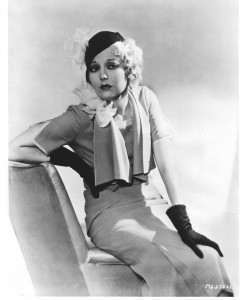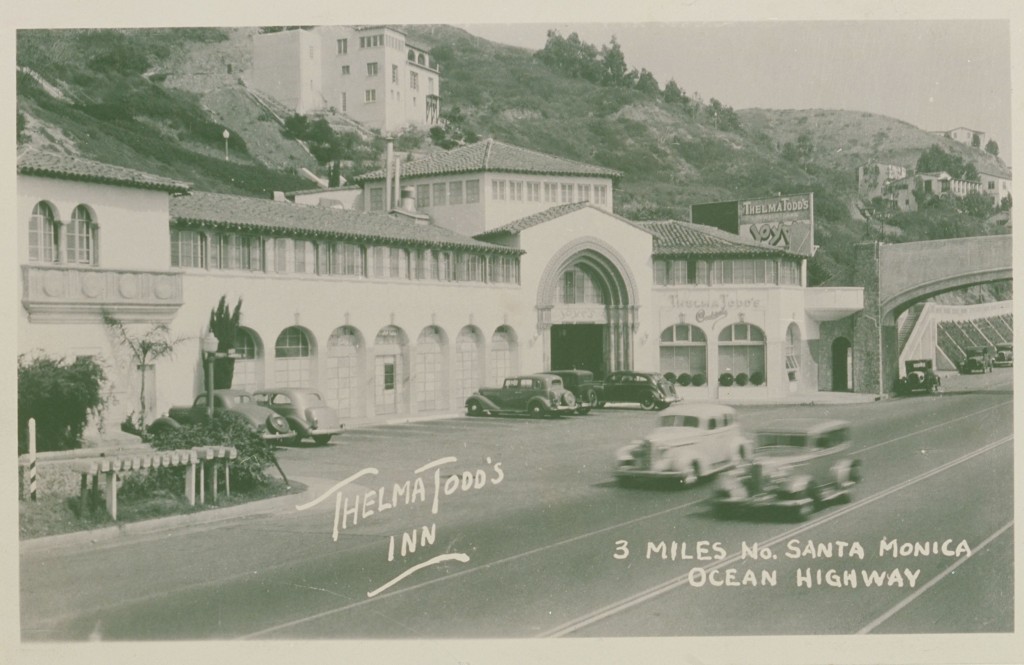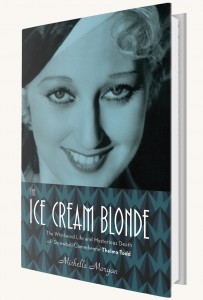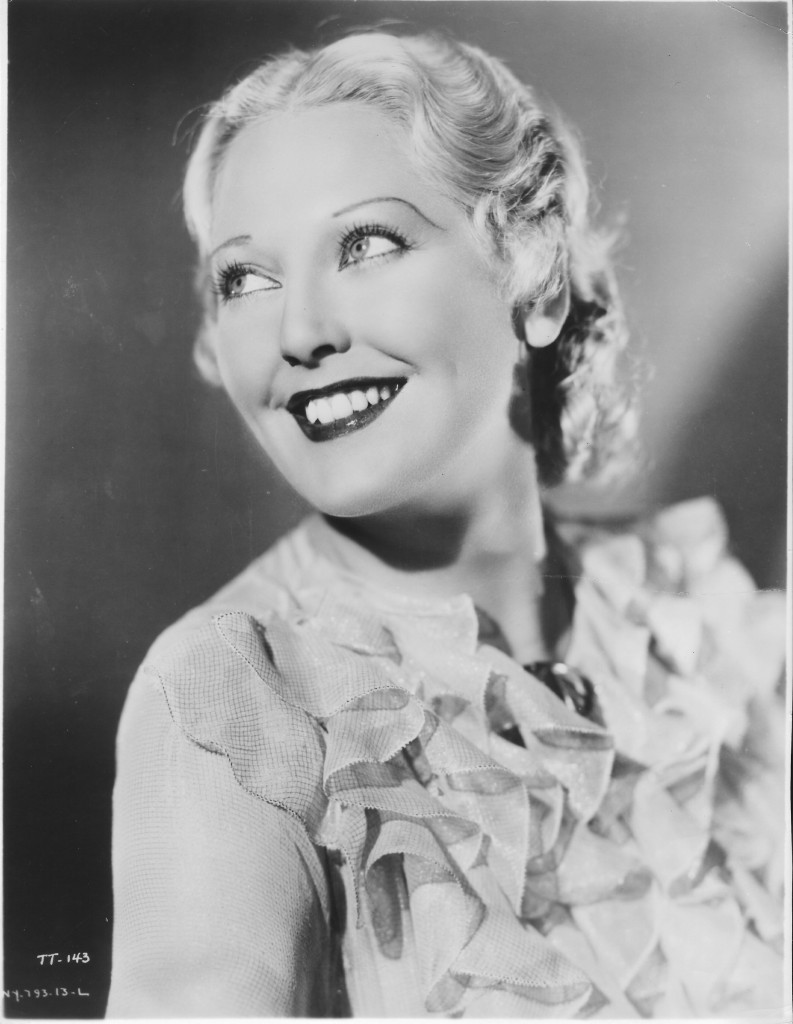More about Michelle Morgan and her new book about Thelma Todd.
Reblogged from
http://www.chicagoreviewpress.com/blog/behind-the-scenes-michelle-morgan-author-of-the-ice-cream-blonde/
November 16, 2015 • Behind the Scenes

At the height of her fame in the early 1930s, film star Thelma Todd was connected not only to major directors, actors, and producers but also to mob bosses and thugs who wanted a piece of the action at her renowned restaurant, Thelma Todd’s Sidewalk Café. So, it’s maybe not a surprise that her life came to an end under suspicious circumstances.
Michelle Morgan’s new book, The Ice Cream Blonde: The Whirlwind Life and Mysterious Death of Screwball Comedienne Thelma Todd, takes readers on a journey from the actress’s childhood to her climb through the Hollywood ranks to the day she was found dead in her car in her garage. The author had the opportunity to comb through hundreds of letters, FBI files, death reports, and press clippings, and she used them in her book to both paint a clear picture of Todd’s life and explore in depth whether the star died accidentally, committed suicide, or was murdered. Here, Morgan goes deep on her investigation, her favorite Todd films, and what she thinks might have become of the actress had she lived.
Most of your other books are on Marilyn Monroe and Madonna, both household names. When did you realize you wanted to write about lesser-known Thelma Todd?
When I discovered Thelma, it was as a result of doing research for a Marilyn Monroe book. I came across a letter from Elia Kazan, telling Marilyn to stop hanging around with Pat De Cicco. I was intrigued because I’d never heard his name before. When I found out that his wife was Thelma Todd and she died under mysterious circumstances, I was even more intrigued. I did a little bit of online research, but there were so many conflicting stories and rumors about Thelma that I didn’t know what to believe. I carried on with my Marilyn Monroe research, but Thelma wouldn’t leave me alone. I felt as though she was knocking on my head constantly, demanding I tell her story. I started to research more into her life, and before I knew it, I was totally hooked. I knew I had to write her biography, and I knew it wouldn’t be easy, but that just made me all the more determined.
In investigating Todd’s death, you were able to access files and evidence unseen by the public until now. How did you come by these materials?
All I can say is thank goodness for collectors. The FBI records had all been destroyed some years ago, and they must have gotten so sick of me reapplying over and over again, just in case they managed to find them. They kept telling me they’d been destroyed, so finally I had to give up and come to terms with the fact that I would not be able to use them. Just as I resigned myself to that, a collector came forward who told me that he actually had the files in his collection. He was able to give me access to everything he had, along with some important e-mails too.
Another collector helped me with interviews. He had done research into Thelma’s life in the 1980s and had spoken to a childhood friend and officers associated with the actress’s death investigation. He was a great person to correspond with and prompted me to go off in directions I had not thought about before.
Then there was a friend of mine who happened to be writing a book about Hal Roach. He was spending time trawling the Roach archives when I was writing my book, so he was able to send me interesting snippets every now and again. I was very grateful to him for taking the time to do that, especially since he was writing his own book.
Another lady trawled through the Glasgow library archives to find reports of Thelma’s trip to Scotland. Thelma had given a very in-depth interview to a handful of reporters in her hotel room, and she even spoke about the subject of gangsters, with no prompting from the writers at all. These articles were incredible because they showed that she was fully aware of (and had been bothered by) gangsters several years before she died. As far as I know, this interview was the one and only time Thelma ever mentioned any involvement with gangsters, so the articles were absolutely crucial to my research.
Todd appeared in dozens of films before her death. How many of them did you end up seeing while conducting your research? Can you name your favorites?

Every film that is available on DVD or on the Internet, I watched. It was brilliant to see Thelma on screen, but at the same time it could be frustrating, too, because sometimes she was only in the film for brief moments. I would watch the whole thing, and she would only pop up for one scene, when I wanted so much for her to be in the entire film! Occasionally, though, I’d find a film that she had a good part in, and that was a real treat. Speak Easily is one example, and You Made Me Love You is another. The latter has actually just been released on DVD, but when I was writing the book, it was only available in snippets on a website. This was frustrating because none of the pieces seemed to be in any particular order. I had to watch them all randomly, note down what sequence I thought they went in, and then finally was able to see the whole film in correct order. Needless to say, now that it is on DVD, I have put it on my Christmas list. I will look forward to watching it in one big chunk instead of twelve tiny ones!
Away from the feature films were the shorts she made for Hal Roach. I watched every film I could find, often dozens of times. I absolutely adore the shorts Thelma made with ZaSu Pitts, and the ones with Patsy Kelly are funny, too. Charley Chase and Laurel and Hardy are hysterical, of course, and I really enjoyed watching those.
Todd often marched to the beat of her own drum. She had to defy her father’s wishes to some degree to start her career in show business, she went out of her way to help poorly treated female costars such as Patsy Kelly, and she started her own restaurant when the film industry grew tiresome. Would she have been seen as brave or radical in her day?
I think she definitely would have been seen as brave and radical. To be honest, I think most actresses were pretty rebellious back in the 1920s and 1930s. After all, it was expected that women should be there for their husbands, tending to the house and caring for the children. Actresses wanted something much more out of their lives, and this often caused raised eyebrows within their families.
Thelma was incredible in that she was not just thinking about her next film role or her next social event; she was actively looking at things she could do when her acting career came to an end. She was astute; she had seen other women’s careers come crashing down as soon as they hit their thirties, and so she planned her future in things that did not relate to acting, such as running her café. I am writing about Carole Lombard at the moment, and she had the same kind of outlook. I have documents that show she was thinking seriously about her future and planning what to do next. Unfortunately, both actresses would not live long enough to see what would become of their careers and lives. That in itself is a huge tragedy.
The book seems to avoid making an ultimate conclusion as to what exactly happened to Todd the night she died. How did you keep track of the various potential players in her death? And, in your mind, is there a definitive guilty party?
I say in the book that piecing together Thelma’s death was like putting together a five-thousand-piece jigsaw puzzle of the sky at night, and that is true. I made lists of all the people, documented who they were, what they said, what they believed happened to Thelma when she died. Then I wrote a time line of what we know for sure (e.g., she definitely went to a party; she danced with her friends and saw her ex-husband). Then I went through each possible scenario and decided whether or not that story could be true.

For instance, a popular theory is that she was locked out of her house and climbed up 271 cliff-side stairs in the middle of the night in order to take shelter in her garage. This seems quite simple—until you start to analyze every aspect of it. For instance, why would she trek up the hillside instead of waking her partner, Roland West, as she had done in the past? Why was her hair and makeup still perfect when the wind was howling and blowing dust from the hill? Why did she walk up the hill when she was known to have an old ankle injury and a thorough dislike for walking? Why would she not take shelter in any of the nooks and crannies that surrounded the café building? And in addition to that, didn’t she know anyone living on that hillside that may have been able to let her use their phone? Just so many questions to think about.
I looked at all the other scenarios and kept notes about each one, going through the coroner’s report, finding inaccuracies and strange answers, and writing down everything I thought was important. I also used my family as a sounding board. I would say to my husband, “Look at this photo. What do you think of this? And what do you think of that?” He repairs cars in his spare time, so he was a good person to talk to about the workings of Thelma’s car.
When the book went to Chicago Review Press for editing, the death section became even more complicated because then I had editors asking questions, too. Although it was certainly mind-boggling and headache-inducing at the time, I’m extremely grateful for that process now because it made me think even harder about what I was saying and how and why things could (or could not) have happened.
As far as a guilty party, I believe that though we’ll never know exactly what Roland West’s part in all this was, he most certainly is guilty of not actively looking for Thelma on the Sunday she disappeared. He did not call her mother or the police; he did not go out of the building; he did nothing at all to find her. Not even when someone called looking to see why she hadn’t turned up for a party, or when invited guests arrived at the café wondering where Thelma was. Not once did he think, “Maybe something is wrong here.” But then maybe that is because he knew there was something wrong and he had no idea what to do about it.
 Thelma loved her time in England, and I think certainly she would have gone back to make some films. On several occasions, she told reporters that she desperately wanted to go back, and then on her last evening she was actively making plans with actor Stanley Lupino to make another film together. I like to think she would have settled in England and gone on to become a stage or character actress. Certainly I think she was tiring of Hal Roach and Hollywood in general. She was definitely looking for a change and spoke about that a lot in the last few months of her life.
Thelma loved her time in England, and I think certainly she would have gone back to make some films. On several occasions, she told reporters that she desperately wanted to go back, and then on her last evening she was actively making plans with actor Stanley Lupino to make another film together. I like to think she would have settled in England and gone on to become a stage or character actress. Certainly I think she was tiring of Hal Roach and Hollywood in general. She was definitely looking for a change and spoke about that a lot in the last few months of her life.
The Ice Cream Blonde: The Whirlwind Life and Mysterious Death of Screwball Comedienne Thelma Todd by Michelle Morgan published November 1, 2015. It is available wherever books and e-books are sold, including our website.
Behind the Scenes: Michelle Morgan, Author of The Ice Cream Blonde

At the height of her fame in the early 1930s, film star Thelma Todd was connected not only to major directors, actors, and producers but also to mob bosses and thugs who wanted a piece of the action at her renowned restaurant, Thelma Todd’s Sidewalk Café. So, it’s maybe not a surprise that her life came to an end under suspicious circumstances.
Michelle Morgan’s new book, The Ice Cream Blonde: The Whirlwind Life and Mysterious Death of Screwball Comedienne Thelma Todd, takes readers on a journey from the actress’s childhood to her climb through the Hollywood ranks to the day she was found dead in her car in her garage. The author had the opportunity to comb through hundreds of letters, FBI files, death reports, and press clippings, and she used them in her book to both paint a clear picture of Todd’s life and explore in depth whether the star died accidentally, committed suicide, or was murdered. Here, Morgan goes deep on her investigation, her favorite Todd films, and what she thinks might have become of the actress had she lived.
Most of your other books are on Marilyn Monroe and Madonna, both household names. When did you realize you wanted to write about lesser-known Thelma Todd?
When I discovered Thelma, it was as a result of doing research for a Marilyn Monroe book. I came across a letter from Elia Kazan, telling Marilyn to stop hanging around with Pat De Cicco. I was intrigued because I’d never heard his name before. When I found out that his wife was Thelma Todd and she died under mysterious circumstances, I was even more intrigued. I did a little bit of online research, but there were so many conflicting stories and rumors about Thelma that I didn’t know what to believe. I carried on with my Marilyn Monroe research, but Thelma wouldn’t leave me alone. I felt as though she was knocking on my head constantly, demanding I tell her story. I started to research more into her life, and before I knew it, I was totally hooked. I knew I had to write her biography, and I knew it wouldn’t be easy, but that just made me all the more determined.
In investigating Todd’s death, you were able to access files and evidence unseen by the public until now. How did you come by these materials?
All I can say is thank goodness for collectors. The FBI records had all been destroyed some years ago, and they must have gotten so sick of me reapplying over and over again, just in case they managed to find them. They kept telling me they’d been destroyed, so finally I had to give up and come to terms with the fact that I would not be able to use them. Just as I resigned myself to that, a collector came forward who told me that he actually had the files in his collection. He was able to give me access to everything he had, along with some important e-mails too.
Another collector helped me with interviews. He had done research into Thelma’s life in the 1980s and had spoken to a childhood friend and officers associated with the actress’s death investigation. He was a great person to correspond with and prompted me to go off in directions I had not thought about before.
Then there was a friend of mine who happened to be writing a book about Hal Roach. He was spending time trawling the Roach archives when I was writing my book, so he was able to send me interesting snippets every now and again. I was very grateful to him for taking the time to do that, especially since he was writing his own book.
Aside from the repiecing of the criminal investigation, what was your research process for the book like? What sources did you find most valuable to make Todd three-dimensional?
Because Thelma is not as well known as, say, Marilyn Monroe or Bette Davis, there was very little written about her in terms of books. I bought and read many biographies about her costars and contemporaries, and aside from brief mentions of her death, there was literally nothing about her at all. One book about her costar Buster Keaton didn’t even mention the film they made together, and that was incredibly frustrating.
In the end, I found the best source to be the huge coroner’s report on her death, which I was able to order from the States. It not only gave details of Thelma’s last hours but also glimpses into her personality, her friends, her likes, and dislikes, too. There was even a story about her breaking the glass of her apartment window so that she could wake up her partner Roland West when she locked herself out one evening. Little stories like that told me a lot about her personality. I also used reports such as her will, her autopsy, letters, and other documents, all of which were very useful. Then my husband found a whole host of notes and other items in a library, all of which had been gathered by an author many years ago. These items were great because they pointed me in various directions that I may not have thought about.
Next were contemporary magazines and newspapers, news reports, and film footage. I was blessed with help from some fantastic librarians who went out of their way to find mentions of Thelma in obscure newspapers. One lady (who is now a friend of mine) went through tons of microfiche articles in the library throughout December of last year, sending me anything she could find about Thelma’s death. She even sent me scans on Christmas Eve. She was an angel to this project, and I remain very grateful.Another lady trawled through the Glasgow library archives to find reports of Thelma’s trip to Scotland. Thelma had given a very in-depth interview to a handful of reporters in her hotel room, and she even spoke about the subject of gangsters, with no prompting from the writers at all. These articles were incredible because they showed that she was fully aware of (and had been bothered by) gangsters several years before she died. As far as I know, this interview was the one and only time Thelma ever mentioned any involvement with gangsters, so the articles were absolutely crucial to my research.
Todd appeared in dozens of films before her death. How many of them did you end up seeing while conducting your research? Can you name your favorites?

In this publicity photo for Speak Easily (1932), Thelma sports something of a “gangster moll’s” look. In reality she was anything but. Courtesy of James and Joyce Brubaker.
Away from the feature films were the shorts she made for Hal Roach. I watched every film I could find, often dozens of times. I absolutely adore the shorts Thelma made with ZaSu Pitts, and the ones with Patsy Kelly are funny, too. Charley Chase and Laurel and Hardy are hysterical, of course, and I really enjoyed watching those.
Todd often marched to the beat of her own drum. She had to defy her father’s wishes to some degree to start her career in show business, she went out of her way to help poorly treated female costars such as Patsy Kelly, and she started her own restaurant when the film industry grew tiresome. Would she have been seen as brave or radical in her day?
I think she definitely would have been seen as brave and radical. To be honest, I think most actresses were pretty rebellious back in the 1920s and 1930s. After all, it was expected that women should be there for their husbands, tending to the house and caring for the children. Actresses wanted something much more out of their lives, and this often caused raised eyebrows within their families.
Thelma was incredible in that she was not just thinking about her next film role or her next social event; she was actively looking at things she could do when her acting career came to an end. She was astute; she had seen other women’s careers come crashing down as soon as they hit their thirties, and so she planned her future in things that did not relate to acting, such as running her café. I am writing about Carole Lombard at the moment, and she had the same kind of outlook. I have documents that show she was thinking seriously about her future and planning what to do next. Unfortunately, both actresses would not live long enough to see what would become of their careers and lives. That in itself is a huge tragedy.
The book seems to avoid making an ultimate conclusion as to what exactly happened to Todd the night she died. How did you keep track of the various potential players in her death? And, in your mind, is there a definitive guilty party?
I say in the book that piecing together Thelma’s death was like putting together a five-thousand-piece jigsaw puzzle of the sky at night, and that is true. I made lists of all the people, documented who they were, what they said, what they believed happened to Thelma when she died. Then I wrote a time line of what we know for sure (e.g., she definitely went to a party; she danced with her friends and saw her ex-husband). Then I went through each possible scenario and decided whether or not that story could be true.

A publicity postcard for Thelma Todd’s Inn. Courtesy of Santa Monica Public Library Image Archives, Pacific Palisades Historical Society Collection
I looked at all the other scenarios and kept notes about each one, going through the coroner’s report, finding inaccuracies and strange answers, and writing down everything I thought was important. I also used my family as a sounding board. I would say to my husband, “Look at this photo. What do you think of this? And what do you think of that?” He repairs cars in his spare time, so he was a good person to talk to about the workings of Thelma’s car.
When the book went to Chicago Review Press for editing, the death section became even more complicated because then I had editors asking questions, too. Although it was certainly mind-boggling and headache-inducing at the time, I’m extremely grateful for that process now because it made me think even harder about what I was saying and how and why things could (or could not) have happened.
As far as a guilty party, I believe that though we’ll never know exactly what Roland West’s part in all this was, he most certainly is guilty of not actively looking for Thelma on the Sunday she disappeared. He did not call her mother or the police; he did not go out of the building; he did nothing at all to find her. Not even when someone called looking to see why she hadn’t turned up for a party, or when invited guests arrived at the café wondering where Thelma was. Not once did he think, “Maybe something is wrong here.” But then maybe that is because he knew there was something wrong and he had no idea what to do about it.
Do you think there’s anything Todd could have done differently to avoid her fate? Where do you think her career might have gone had she lived?
 Thelma loved her time in England, and I think certainly she would have gone back to make some films. On several occasions, she told reporters that she desperately wanted to go back, and then on her last evening she was actively making plans with actor Stanley Lupino to make another film together. I like to think she would have settled in England and gone on to become a stage or character actress. Certainly I think she was tiring of Hal Roach and Hollywood in general. She was definitely looking for a change and spoke about that a lot in the last few months of her life.
Thelma loved her time in England, and I think certainly she would have gone back to make some films. On several occasions, she told reporters that she desperately wanted to go back, and then on her last evening she was actively making plans with actor Stanley Lupino to make another film together. I like to think she would have settled in England and gone on to become a stage or character actress. Certainly I think she was tiring of Hal Roach and Hollywood in general. She was definitely looking for a change and spoke about that a lot in the last few months of her life.
As for avoiding her fate, that’s a good question. If gangsters were involved in her death, then certainly the café was a significant factor in their interest. If she had not renewed ties with Roland West and moved to the café, then I think certainly she would have avoided some of the terrible things that happened in the last year of her life. It is just awfully sad that by actively seeking a different way of life, by looking to the future and making a move away from the movies, she actually hastened her passing. That is a real tragedy and a very sad end for someone who gave so much for the entertainment of others.
—compiled by Geoff George
The Ice Cream Blonde: The Whirlwind Life and Mysterious Death of Screwball Comedienne Thelma Todd by Michelle Morgan published November 1, 2015. It is available wherever books and e-books are sold, including our website.
A


No comments:
Post a Comment